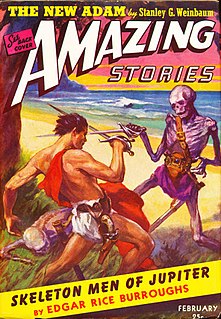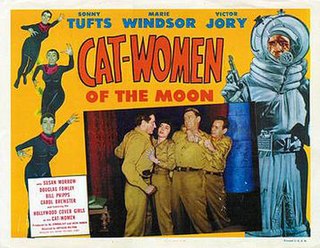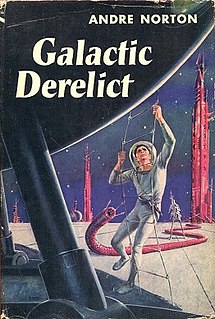
Between Planets is a juvenile science fiction novel by American writer Robert A. Heinlein, originally serialized in Blue Book magazine in 1951 as "Planets in Combat". It was published in hardcover that year by Scribner's as part of the Heinlein juveniles.

Childhood's End is a 1953 science fiction novel by the British author Arthur C. Clarke. The story follows the peaceful alien invasion of Earth by the mysterious Overlords, whose arrival begins decades of apparent utopia under indirect alien rule, at the cost of human identity and culture.

The Man Who Fell to Earth is a 1963 science fiction novel by American author Walter Tevis, about an extraterrestrial who lands on Earth seeking a way to ferry his people to Earth from his home planet, which is suffering from a severe drought. The novel served as the basis for the 1976 film by Nicolas Roeg as well as a 1987 television adaptation and a 2022 television series.
The Noon Universe is a fictional future setting for a number of hard science fiction novels written by Arkady and Boris Strugatsky. The universe is named after Noon: 22nd Century, chronologically the first novel from the series.

Planetary romance is a subgenre of science fiction in which the bulk of the action consists of adventures on one or more exotic alien planets, characterized by distinctive physical and cultural backgrounds. Some planetary romances take place against the background of a future culture where travel between worlds by spaceship is commonplace; others, particularly the earliest examples of the genre, do not, and invoke flying carpets, astral projection, or other methods of getting between planets. In either case, it is the planetside adventures which are the focus of the story, not the mode of travel.

The Sands of Mars is a science fiction novel by English writer Arthur C. Clarke. While he was already popular as a short story writer and as a magazine contributor, The Sands of Mars was also a prelude to Clarke's becoming one of the world's foremost writers of science fiction novels. The story was published in 1951, before humans had achieved space flight. It is set principally on the planet Mars, which has been settled by humans and is used essentially as a research establishment. The story setting is that Mars has been surveyed but not fully explored on the ground. The Sands of Mars was Clarke's first published novel.
Angus MacVicar was a Scottish author with a wide-ranging output. His greatest successes came in three separate genres: crime thrillers, juvenile science fiction, and autobiography. His early writing was interrupted by wartime service with the Royal Scots Fusiliers, hence most of his fiction appeared in the two decades following World War II.

The Hammer of God is a science fiction novel by Arthur C. Clarke originally published in 1993. Set in the year 2109, it deals with the discovery of an asteroid to be on course to collide with Earth and depicts the mission for deflecting the asteroid using fusion thermal rockets.

Commando Cody: Sky Marshal of the Universe is a 1953 American black-and-white twelve-chapter movie serial from Republic Pictures, which began life as a proposed syndicated television series. It consists of twelve 25-minute sequential episodes directed by Harry Keller, Franklin Adreon, and Fred C. Brannon. It stars Judd Holdren, Aline Towne, Gregory Gaye, William Schallert, Richard Crane, and Craig Kelly.

Jupiter, the largest planet in the Solar System, has appeared in works of fiction across several centuries. The way the planet has been depicted has evolved as more has become known about its composition; it was initially portrayed as being entirely solid, later as having a high-pressure atmosphere with a solid surface underneath, and finally as being entirely gaseous. It was a popular setting during the pulp era of science fiction. Life on the planet has variously been depicted as identical to humans, larger versions of humans, and non-human. Non-human life on Jupiter has been portrayed as primitive in some works and more advanced than humans in others.

Cat-Women of the Moon is an independently made 1953 American black-and-white three-dimensional science-fiction film, produced by Jack Rabin and Al Zimbalist, directed by Arthur Hilton, that stars Sonny Tufts, Victor Jory, and Marie Windsor. The film was released by Astor Pictures.

Space Apprentice, also known as Probationers, is a science fiction novel by Soviet-Russian writers Arkady and Boris Strugatsky, originally published in 1962. It is set in the Noon Universe following The Land of Crimson Clouds and "Destination Amalthea", hundreds of years before the other Noon novels.

Milcząca Gwiazda, literal English translation The Silent Star, is a 1960 East German/Polish color science fiction film based on the 1951 science fiction novel The Astronauts by Polish science fiction writer Stanisław Lem. It was directed by Kurt Maetzig, and stars Günther Simon, Julius Ongewe and Yoko Tani. The film was first released by Progress Film in East Germany, running 93 min. Variously dubbed and cut versions were also released in English under other titles: First Spaceship on Venus, Planet of the Dead, and Spaceship Venus Does Not Reply.

Flight to Mars is a 1951 American Cinecolor science fiction film drama, produced by Walter Mirisch for Monogram Pictures, directed by Lesley Selander, that stars Marguerite Chapman, Cameron Mitchell, and Arthur Franz.

One in Three Hundred is a science fiction novel by British writer J. T. McIntosh. It was originally published as three novellas in The Magazine of Fantasy and Science Fiction in 1953-54, and was then published by Doubleday & Company, Inc. During 1956 the novel was reissued by Ace as Ace Double D-113, in a dos-à-dos binding with Dwight V. Swain's The Transposed Man.

Return to the Lost Planet is a 1954 juvenile science fiction novel by Angus MacVicar, published by Burke, London. It is the second of the Lost Planet series, which was adapted for radio and television.

Eolomea is a 1972 science fiction film directed by Herrmann Zschoche, based on the book of the same name by Angel Wagenstein. The film was an East German/Soviet/Bulgarian coproduction.

Galactic Derelict is a science fiction novel by American writer Andre Norton, the second in her Time Traders series. It was first published in 1959, and as of 2012, had been reprinted in eight editions. It is part of Norton's Forerunner universe.

Beyond the Blue Event Horizon is a science fiction novel by the American writer Frederik Pohl, a sequel to his 1977 novel Gateway and the second book in the Heechee series. It was a finalist for two major annual awards, the 1981 Hugo Award for Best Novel and the 1980 Nebula Award. In the 1981 poll of Locus readers it finished second to The Snow Queen by Joan Vinge.

Far Centaurus is a science fiction short story by Canadian-American writer A. E. van Vogt, first published in Astounding Science Fiction in 1944. Writer and critic P. Schuyler Miller called it "unforgettable and unforgotten."


















